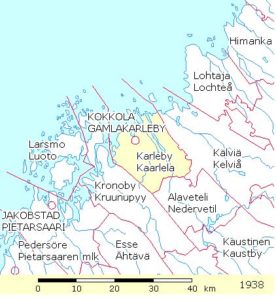By Per Björkgren – “Karlebynejden No. 25, 1993”.
Translated by June Pelo

A genealogist often comes to a blank wall, but after diverse contact with other researchers he can once again go forward or backward.
For an American emigrant of the third generation to start to think about his roots is a difficult state of affairs. He has no one to turn to, no church or parish archive to search in. No letter contact had existed for two generations. Here the researcher had to turn to unknown help.
The undersigned began to dig into the past and went back four generations.
The oldest son Erik, born 13 October 1829 was the family’s ancestor; he had a sister Maria Elisabeth, born 16 July 1834. She had moved to Gamlakarleby and married seaman Fredrik Svenn, born 11 July 1843. In the church book was a note: moved away 1865.
The younger brother Karl-Johan, born 14 November 1840, had a daughter Anna, born 10 November 1901, who married sausage maker Axel Haga. She was his first wife. Kronlund Family).
Further searching revealed only that the father Fredrik went away and left his wife and little son Alexander, born 27 October 1864 in Gamlakarleby. Alexander lived with his mother until he was eighteen years old, then he got papers to emigrate to America (Michigan), where he married 1891 to Brita-Lena Wargström, born 6 January 1857. (She belonged to the [Friis|Lars Friis] Family.) Her parents had emigrated earlier and were natives in the area. The couple had two children: Helena, born 27 June 1892 and Bernhard, born 21 April 1901. The parents died in Michigan when the children were small. Brita-Lena died 1912 and Alexander 1915. (Alexander’s mother died 1910.)
Thereafter contact with the homeland was broken. For some unknown reason the parents had not told their children where they had come from. How these children survived was a miracle. Bernhard was eleven and his sister a little older. By and by Helena married and had a large family. Bernhard grew up and became a Ph.D. He died as late as 1988 without any knowledge of his family and their origin though he had searched in all of Scandinavia. As a child he had remembered that Swedish had been the mother tongue of his parents. That their roots were from a little Swedish group of people in Finland was unimaginable.
After the father’s death his large book collection was divided between sons Edmund, born 15 June 1933 and Robert Swanson, born 1 June 1940. A load of old books fell to Ed, including his ancestor’s old Swedish language family Bible. In it the grandfather had put a letter that he got from his mother Maria Elisabeth. This was written 1910. A light began to shine, for Ed had also begun to search. But problems remained. Various names were noted in the letter, but none of those people could still be living. The letter was enclosed in a yellowed envelope which appeared to come from Finland, judging by the postage stamp. But the place could not be read because the postmark wasn’t clear and part of the beginning and ending of Gamlakarleby had disappeared. Previously when people wrote letters, at least to America, the name of the sender’s location was left off. Before the date was written “God be with you.”
Ed was a man of action. He sent the letter to the Finnish Ambassador. Now the avalanche was rolling. After some months, this area’s genealogist Grand Old Man Frans Lillsunde received a query from Helsingfors about the names mentioned in the letter. He analyzed the letter and determined the people to be part of the Björkgren and Viklund families, to which the family ancestor Maria Elisabeth belonged.
Ed had reached his goal: his roots. That kind of an experience gives a genealogist more inspiration to continue, and for Ed Swanson his craving for knowledge and interest in his roots resulted in a trip to Karleby. Together with his wife Charlotte, he visited his ancestor’s home area during midsummer festival 1990. His indescribable joy to have found his roots was touching to behold. After a coffee welcome at my house, we drove to the cemetery. A few days earlier I had found his ancestor Maria Elisabeth’s grave under a simple rusty iron cross at Maria Cemetery and adorned it with flowers. I did not reveal this to Ed and Charlotte before they came to the grave and began to read the name MARIA ELISABETH on the little metal plate that was fastened to the cross. The vigorous Air Force officer burst into tears as he knelt and again spelled out his ancestor’s name MARIA ELISABETH. I do not know what moved within him, but perhaps he was glad that the questions his father often had were now answered. He had been the lucky link that brought together a “lost” branch of the Björkgren family. We who were at the grave saw that neither time nor distance can erase the strong ties that bind our families together and we realize how valuable it is to preserve these relations. Contact with this family continues with a meeting of the entire Björkgren family in the summer of 1994. Probably we will then meet several members from the new family branch in America. It is fantastic how an incomplete postmark on an envelope could find the way home to its roots and a new family connection.